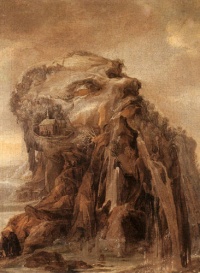Winter
From The Art and Popular Culture Encyclopedia
| Revision as of 07:14, 26 September 2012 Jahsonic (Talk | contribs) ← Previous diff |
Revision as of 21:12, 2 April 2013 Jahsonic (Talk | contribs) Next diff → |
||
| Line 1: | Line 1: | ||
| + | [[Image:Joos de Momper.jpg|thumb|right|200px|''[[Winter]]'', one of the ''[[The Four Seasons (Joos de Momper)|The Four Seasons]]'' (early [[17th century]]) by [[Joos de Momper]]]] | ||
| [[Image:The Winter (1563) by Arcimboldo in the Kunsthistorisches Museum Wien.jpg |thumb|left|200px|''[[The Winter]]'' (1563) by [[Giuseppe Arcimboldo|Arcimboldo]]]] | [[Image:The Winter (1563) by Arcimboldo in the Kunsthistorisches Museum Wien.jpg |thumb|left|200px|''[[The Winter]]'' (1563) by [[Giuseppe Arcimboldo|Arcimboldo]]]] | ||
| {{Template}} | {{Template}} | ||
Revision as of 21:12, 2 April 2013
|
Related e |
|
Featured: |
Traditionally the fourth of the four seasons, typically regarded as being from December 21 to March 20 in Northern Hemisphere regions and from June 21 to September 20 in Southern Hemisphere regions. Usually marked by the applicable hemisphere of the planet being at its minimum angle of exposure to the Sun, resulting in short days and typically the time period with the lowest atmospheric temperatures for the region.
Contents |
Psychology
Passing seasons change the habits and moods of people. During the winter months in the Northern Hemisphere, a gloominess (nicknamed "winter blues," "February blahs," or "holiday depression") or doldrums is informally noted amongst people. The severest cases of this type of depression are diagnosed as seasonal affective disorder (SAD). Symptoms include excess sleeping, tiredness, depression, and physical aches. Although causes include genetic disposition and stress, the prevailing environmental influence is decreased exposure to light because of the angle of the sun and cloud cover.
Symbolism
Some use winter to suggest death, as in Robert Frost's "Stopping by Woods on a Snowy Evening." Some use it to suggest the absence of hope, as in C.S. Lewis' The Lion, the Witch and the Wardrobe, where it was always winter but never Christmas. Winter is one concerto in Antonio Vivaldi's "The Four Seasons," and there are many examples of four paintings all showing the same scene in different seasons. Ursula K. LeGuin's novel The Left Hand of Darkness is set on a planet named Winter. In Alex Raymond's comic strip Flash Gordon, there is a land called Frigia, where it is always winter. The land of Frigia is also featured in the serial Flash Gordon Conquers the Universe. Other uses of winter in the graphic arts occur in Winsor McCay's Little Nemo in Slumberland. There are many films in which a winter setting plays an important role, Fargo being an example. Novels such as Ethan Frome also use a winter setting to mirror the bleak, frozen feelings that the characters harbor. The film Requiem for a Dream concludes with "Act III: Winter," in which the movie reaches its chilling climax.
Mythology
In various cultures
In Greek mythology, Hades kidnapped Persephone to be his wife. Zeus ordered Hades to return her to Demeter, the goddess of the Earth and her mother. However, Hades tricked Persephone into eating the food of the dead, so Zeus decreed that Persephone would spend six months with Demeter and six months with Hades. During the time her daughter is with Hades, Demeter became depressed and caused winter. In Welsh mythology, Gwyn ap Nudd abducted a maiden named Creiddylad. On May Day, her lover, Gwythr ap Greidawl, fought Gwyn to win her back. The battle between them represented the contest between summer and winter.
Personifications
- Old Man Winter, also known as Father Winter
- Jack Frost
- Ded Moroz
- Snegurochka
- Vetr

_by_Arcimboldo_in_the_Kunsthistorisches_Museum_Wien.jpg)

